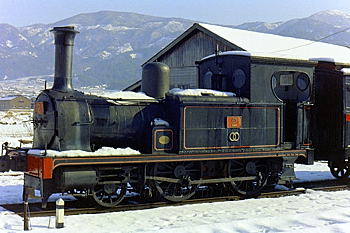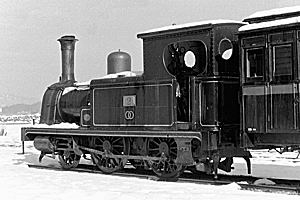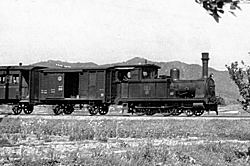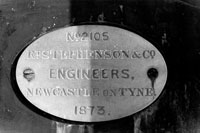Steam Locomotive
|  Kaya Railway's No.2 (ex-No.16) Jan 1972 |
|
In western Japan, two years later in 1874, a line opened between Osaka and Kobe and later, separately connected to Tokyo.
Four tank and two tender locomotives (No.11 and 12) were imported from Britain for the opening between Osaka and Kobe.
Four of the Tank-Engines were manufactured by Robert Stephenson and Company and their manufactured numbers were 2102, 2103, 2104 and 2105. They were consequently named No.13, 14, 15 and 16. (presumption) During 1876, numbering rules were revised, Tokyo area was assigned to odd numbers, Osaka area was assigned to even numbers. From the revision, Osaka area numbers were changed to ; No.13 to No.6, No.14 to No.8, No.15 to No.10 and No.16 to No.12. During July 1884 to June 1885, they were moved to the Tokyo area. During 1906, their class name was changed to Class 120, and their numbers were ; No.6 (ex-No.13) to No.120, No.8(ex-No.14) to No.121, No.10 (ex-No.15) to No.122 and No.12 (ex-No.16) to No.123.
No.121 was sold to the Hinokami Railway Co. (now Kisuki line between Kisuki and Shinji) during March 1915 and named to Hikami's No.1. The Hinokami Railway Co. was socialized during the 1st of August, 1934, therefore, Hinokami's No.1 was renationalized and changed back to No.121. Later No.121 was again sold to Nanso Railway Co. (Chiba prefecture) and was named Nanso's No.1. Nanso Railway suspended line service during 1939 and was closed during 1944(?). After Nanso Railway closed, No.121 was missing and feared lost. No.123 was also sold to the Hinokami Railway Co. and was named as Hinokami's No.2. It was moved to the Kaya railway Co. during November 1926. Later, No.2 was actived on Kaya Railway and retired in 1956. After retirement, the company kept that engine in it's own depot. The Kaya railway Co. was closed on the 1st of May 1985, and the site of Kaya station was remade to the Kaya museum. Later No.2 (ex-No.16) was exhibited at that museum. And No.2 was designated as a nationally important cultural property during June 2005. The Kaya museum was closed on the 31st of March 2020, No.2's future is still in the air. |
 The same as class as No.16's No.6 (ex-No.13) No.6 was later renamed to No.120, and it was scrapped during 1939. Photo during 1880s ? |
 The same as class as No.16's No.8 (ex-No.14) No.8 was later renamed to No.121, and it was missing after Nanso Rwy closed during 1939 Photo during 1876-1909 |
Biographic Data Chart No.16
|
| Configuration | 2-4-0 | Dimensions Length (mm) | 8179
| Engine Weight (Operating tons) | 23.37
| Driver size (mm diameter) | 1346
| Boiler pressure (Kg/cm2) | 8.0
| |

No.2 Kaya depot, 1973. |
 No.2 during active service days on the Kaya Railway, Apr 1939. (Photo credit to K.Nishio) |
Introduction
|
Go to Top
|
